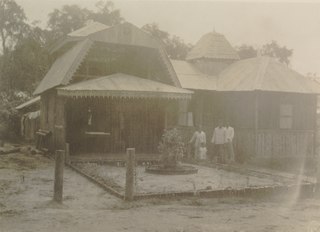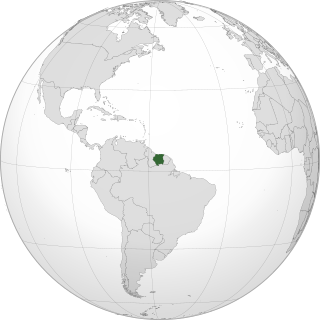
Para is a district of northern Suriname. Para's capital city is Onverwacht, with other towns including Paranam, and Zanderij. Para has a population of 24,700 and an area of 5,393 km2. The district is the mining and forestry centre of Suriname, with many large bauxite mining operations operating. The district is a mixture of forest and savannas.

Cornelis Gerhard Anton de Kom was a Surinamese resistance fighter and anti-colonialist author. He was arrested in Suriname and the protest against his arrest resulted in two deaths. De Kom was subsequently exiled to the Netherlands where he wrote Wij slaven van Suriname, an anti-colonial book. During World War II, he joined the resistance, was arrested, and sent to concentration camps where he died. In 2020, de Kom was added as a subject on the Canon of the Netherlands, a chronological list of fifty key events and people in Dutch history to be taught in schools.

Jodensavanne was a Jewish plantation community in Suriname, South America, and was for a time the centre of Jewish life in the colony. It was established in the 1600s by Sephardi Jews and became more developed and wealthy after a group of Jews fleeing persecution in Brazil settled there in the 1660s. It was located in what is now Para District, about 50 km (31 mi) south of the capital Paramaribo, on the Suriname River. Sugarcane plantations were established and Black African people were used as slave labour. At its height in around 1700 it was home to roughly 500 plantation owners and 9000 slaves. The colony faced regular attacks from Indigenous people, slave revolts, and even raids from the French navy. The community eventually relocated to the capital of Paramaribo. Clearing of grave sites and maintenance of the synagogue ruins has been attempted at various times from the 1940s to the 21st century.

Petrus Norbertus Donders was a Dutch Roman Catholic priest and member of the Redemptorist Congregation. He served in various missions in the Dutch colony of Surinam. He started working in the capital Paramaribo, but is predominantly known for his work in and around the leper colony Batavia, where he died in 1887. Peter Donders was beatified as 'Apostle of the Indians and Lepers' in 1982. The miracle needed was found in the cure of a Dutch child from bone cancer back in 1929.

Michaël Henricus Gertrudis (Michiel) van Kempen is a Dutch writer, art historian and literary critic. He has written novels, short stories, essays, travel literature and scenarios. He was the compiler of a huge range of anthologies of Dutch-Caribbean literature and wrote an extensive history of the literature of Suriname, in two volumes.

Joan or Johan van Scharphuysen, Scharphuizen or Jan van Scherpenhuizen was a Dutch colonist, a judge in Suriname, a slave-trader, colonial governor from 1689 to 1696 on behalf of the Society of Surinam, and a considerable plantation-owner.

Boven-Digoel was a Dutch concentration camp for political prisoners operated in the Dutch East Indies from 1927 to 1947. It was located in a remote area on the banks of the river Digul, in what is now Boven Digoel Regency in South Papua, Indonesia. The site was chosen in 1928 for the internal exile of Indonesians implicated in the 1926 and 1927 communist uprisings in Java and Sumatra. Indonesian nationalists not associated with the Indonesian Communist Party were subsequently also sent there.

Surinamese people are people who identify with the country of Suriname. This connection may be residential, legal, historical or cultural. For most Surinamese, several of these connections exist and are collectively the source of their being Surinamese.
Javanese Surinamese are an ethnic group of Javanese descent in Suriname. They have been present since the late 19th century, when their first members were selected as indentured laborers by the Dutch colonizers from the former Dutch East Indies.

Surinam, also unofficially known as Dutch Guiana, was a Dutch plantation colony in the Guianas, bordered by the equally Dutch colony of Berbice to the west, and the French colony of Cayenne to the east. It later bordered British Guiana from 1831 to 1966.

Netherlands–Suriname relations refers to the current and historical relations between the Netherlands and Suriname. Both nations share historic ties and a common language (Dutch) and are members of the Dutch Language Union.

The history of the Jews in Suriname starts in 1639, as the English government allowed Spanish and Portuguese Jews from the Netherlands, Portugal and Italy to settle the region, coming to the old capital Torarica.
Adjua Gyapiaba, also known as Ajua Japiaba, Api-jaba and Afi Jaba, was a woman from Elmina in contemporary Ghana, who after a heated argument with a fellow Elminan was expelled by the Dutch colonial authorities to Suriname, where she eventually acquired fame as a herbalist and diviner.

Aliarcham (c.1901-1933) was a Sarekat Islam and Indonesian Communist Party party leader, activist and theoretician in the Dutch East Indies. He was a major figure behind the PKI's turn to more radical policies in the mid-1920s. He was arrested by Dutch authorities in 1925 and exiled to the Boven-Digoel concentration camp, where he died in 1933. He became a well-known Martyr, especially among Communists and Indonesian nationalists.

Copieweg camp was a Dutch Internment Camp for German civilians that operated in Surinam during World War II, from 1940 to 1947. They were interned due to their nationality rather than due to proven support for Nazi Germany, although some of them were widely known to be Nazi supporters. Non-German detainees were also sent to this camp after 1942, including a small group of South African conscientious objectors and a few members of the Surinam political opposition including the politician Wim Bos Verschuur. The camp was built on the site of a Roman Catholic Monastery twenty kilometres from Paramaribo which was expanded to house a larger number of detainees.

Louis Johan Alexander Schoonheyt (1903-1986), commonly known as L. J. A. Schoonheyt, was a Dutch medical doctor, writer, and supporter of the National Socialist Movement in the Netherlands before World War II. From 1935 to 1936 he was the camp doctor at the Boven-Digoel concentration camp in New Guinea, Dutch East Indies, and is mostly known today for the book he wrote about his experiences there, Boven-Digoel: Het land van communisten en kannibalen (1936). His praise for the conditions in the camp earned him the ire of the internees, Indonesian nationalists, and Dutch human rights advocates; E. du Perron called him a 'colonial bandit', while many internees burned his book after reading it in the camp.

Soekaesih was a Communist Party of Indonesia activist known for being one of only a handful of female political prisoners exiled by the Netherlands government to Boven-Digoel concentration camp. After being released she traveled to the Netherlands in the late 1930s and campaigned for the camp to be shut down.

The history of Suriname during World War II was mainly focused on protecting the bauxite industry and guarding the borders with French Guiana which was part of Vichy France. From November 1941 onwards, 2,000 American troops were stationed in Suriname who transformed Airstrip Zanderij into a major airport, and constructed defensive works. No actual battles took place in Suriname. There was a political crisis in 1943, because Governor Johannes Kielstra used the state of emergency to imprison political opponents.

Cassipora is an indigenous village of Lokono Amerindians in the resort of Carolina in the Para District in Suriname. The village is located near the Blaka Watra recreation area. It is also near a 17th-century Jewish village, however only the cemetery remains.
Cornelis Reinhard Vaillant was a Dutch lawyer, judge, and colonial governor. He served as Governor of Suriname from 19 July 1816 until 1 April 1822, and as judge on the Supreme Court of the Netherlands from 1838 until 1849.






















